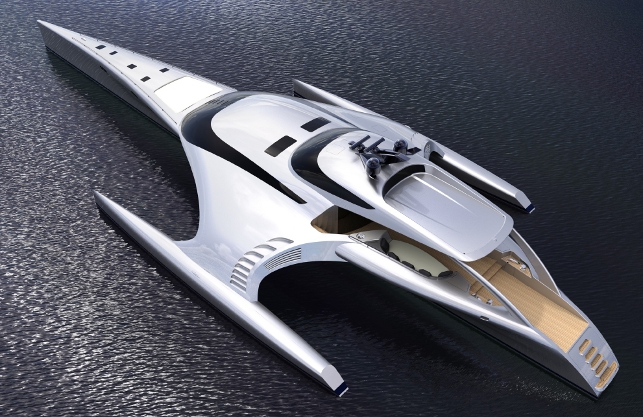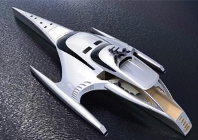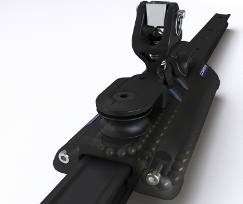Star of the sea
There are superyachts, and then there are superyachts; and even with our limited knowledge we can tell that the Adastra falls into the latter category.

The Adastra
Looking like something normally assigned the tag ‘concept idea’, this 42.5m trimaran with more than a hint of sci-fi spacecraft about it, is currently being built in China for a very lucky (and we assume
rather wealthy) owner.
The result of more than five years of design, it is the outstanding work of Sussex-based John Shuttleworth Yacht Designs.
“The challenge of turning this concept into a viable luxury yacht has led us to further research and to develop new thinking on stability and comfort at sea for this type of craft,” explains owner John Shuttleworth.
“We have undertaken a state-of-the-art structural analysis of all the major components in the yacht in order to achieve the light weight required for very low fuel consumption. This has resulted in a exceptional vessel that is nearing completion in China.”
The Adastra offers comfortable accommodation for nine guests and up to six crew members. Almost every part of the craft is custom built: the superstructure is carbon fibre with Nomex honeycomb core, the hull is a glass and kevlar foam sandwich and the interior features oak cabinetry using honeycomb panels. Carbon fibre hatches, portlights, ladders and even hinges, are all built specifically for the vessel.
Siemens NX design software was used throughout the whole design process, including conceptual design, hull fairing and detailing, structural design, interior design and superstructure and deck gear design and detailing.
Working in 3D allowed Shuttleworth to integrate all the different phases of the design process, from conceptual design to detail drafting. It also enabled the designers to model the complex free-form surface shapes that characterise the deck superstructures, as well as more prismatic engineering forms such as structural components and deck gear.
With a maximum speed of 22.5 knots and a range of 4,000 miles at 17 knots, this multi-hulled monster is using structural design technology and aerodynamics to create the future of luxurious long range cruising.
Sea traveller
Sixty five years on from when it first started making dinghy fittings, British-based firm Lewmar is producing innovative equipment for modern seacraft, including its new HTX Traveller range. A traveller is a rope that controls the sails of the boat. It is fixed to the deck by sliding onto a metal track that uses a ball race system.
Traditionally the balls can escape from this system when the track is removed. However, the new HTX Traveller encloses the ball race system while adding an additional top ball race to aid efficiency.
Updating the traditional design meant adjustments to its initial 2D AutoCAD drawings. Having explored various ideas through sketching the design was moved into Pro/Engineer Wildfire.
The model was put through load testing in Pro/Mechanica before further physical prototype tests.
“First, a 100 per cent SLS rapid prototype was produced from initial design concepts, which was hand finished and painted for concept approval,” says Lewmar designer Mathew Tibbenham.
“The next unit was half rapid prototyped, half machined from solid aluminium; this was used for more functional testing.
“The first production batch was actually made using several vacuum castings while we waited for permanent injection moulding tools to be made, before finally going to full production.” Using such 3D design methods allowed the design team to see what impact the traveller would have on the overall control system.
The end result is a product capable of handle bigger loads but utilising a small number of parts and so reducing costs.
High rolling on the high seas
Specialist Marine Interiors (SMI), a company of boat builders that focuses on designing luxurious living spaces for life at sea, usually remotely designs and manufactures the interiors from its base in Whangarei, New Zealand, to be delivered to a foreign port where they are installed.

The interior of MY Black Pearl
However its latest project, the 31.5m MY Black Pearl, was literally on its doorstep in the city’s harbour. SMI’s interiors are designed and manufactured in tandem with the yacht’s hull and structure, resulting in faster construction times.
The crafty Kiwis have also pioneered a technique of completely isolating the interiors from any of the yacht’s mechanical structure. “Using a multitude of fastening techniques and products any part of our interior is easily removed, allowing unplanned maintenance to be carried out behind our interiors without damaging any of our work,” says SMI’s design manager Scott Moyse.
Using a 3D model of the ship’s structure provided by the shipyard a parametric structural envelope is created using Autodesk Inventor with all of the ship’s systems accounted for during this process. This forms the rough floors, walls and ceilings of the interior space.
From this the furniture designers can construct their designs, and with it being a parametric design any changes in the structure of the boat result in the furniture being modified automatically.
With the superyacht industry being rather small, most of its technology is drawn from other industries: SMI’s entire polishing process uses equipment and materials originally developed for the automotive
industry; while certain yachts require lightweight materials for which the materials have their roots in the aerospace and motorsport industries.
The final product is a bespoke living quarters for you, your family and the vessel’s crew ready for your next champagne-spraying extravagance. 
A look at what innovations are taking place on the water
Default







